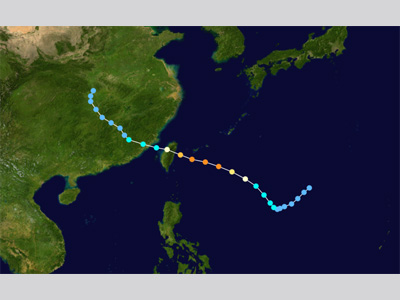China was struck by the short-lived but intense Super Typhoon Nina in August 1975. As a result of the typhoon, the Banquio and Shimantan Dams collapsed, causing unprecedented flooding and destruction downstream. On July 29, 1975, a tropical disturbance arose from a trough line in the Philippine Sea. The disturbance, Tropical Disturbance 04W, moved southwestward for 36 hours as surface and upper-air circulation became more organized and vertically aligned. On 31 July, the storm slowed and turned northwestward before rapidly intensifying and shifting to the west-northwest. The storm reached typhoon status on 1 August and underwent explosive deepening- reconnaissance aircraft data indicated a 63 mb (hPa) drop in sea level pressure at the typhoon center, with maximum surface winds increasing from 120 km/h to 240 km/h (75 mph to 150 mph). On the following day, peak intensity of 185 km/h (115 mph) was attained approximately 368 kilometers (230 miles) east of Taiwan.
The typhoon slowly decreased in intensity as it approached the island, making landfall near the coastal city of Hualien on 3 August with maximum surface winds of 184 km/h (115 mph). Much of the typhoon’s strength was lost as it moved across Taiwan’s central mountain range, fortunately sparing the island’s most populous areas. After the typhoon traveled across Taiwan, it entered the Taiwan Straight (Formosa Strait), the body of water that separates the island from Mainland China. A significantly weakened Nina (peak winds 110 km/h [69 mph]) made a second landfall as a tropical storm near Jinjiang Fujian, China on 3 August. It then moved northwest before shifting north and arriving in the east-central province of Henan on 5 August. The storm brought heavy rainfall as it stalled over this area for 3 days. Approximately 1,060 millimeters (41.7 inches) of rain fell during those three days. The storm produced more rainfall in 24 hours than an average year’s worth of rain in the Henan Province, 800 millimeters (31.5 inches). By August 8, the Banqiao and Shimantan Dams, which had been built in the province to protect against heavy rainfall, were both filled over their capacity. At the Banqiao Reservoir on the Ru River, the water had reached 118 meters (386 feet) and was still rising- the dam could not release the water as fast as its reservoir was filling. Early on August 9, the main part of the Banqiao dam collapsed, sending a wall of water 6 meters (19.7 feet) high and 12 kilometers (7.5 miles) wide rushing down the river channel, followed by 600 million cubic meters of water. Thirty minutes earlier, the Shimantan Reservoir reached its maximum capacity and collapsed. One hundred and twenty (120) million cubic meters of water burst forth from the Shimantan dam and within 5 hours, the entire reservoir was empty. In total, 15.738 billion tons of water poured out onto the Henan Province destroying parts of the city as well as 62 smaller dams. Flood diversions and other systems downstream could not handle the rushing waters; dikes collapsed, creating huge lakes. Several dams were intentionally destroyed by Chinese military air strikes in order to release water in desired directions in attempts to protect larger reservoirs and populations from the floodwaters. By the evening of 9 August, floods had reached the Fuyang Area in the Anhui Province, roughly 250 kilometers away (156 miles). The disaster is reported to have flooded 29 counties in the Henan Province, affected 11 million people and killed over 85,000 (Henan is China’s most populous province). Nina’s trek across Taiwan also left 25 people dead and 168 injured. It was also reported that over 3,000 homes were at least partially collapsed, 39 fishing boats were sunk, and a 16,000 ton Korean freighter, The Sun Star, was capsized. Fast Facts:
Sources:
The River Dragon has come!: The Three Gorges Damn and the Fate of China’s Yangtze River and Its people Wikipedia: Typhoon Nina Joint Typhoon Warning Center- ATCR on he 1975 Typhoon Season http://en.wikipedia.org/wiki/Banqiao_Dam |


